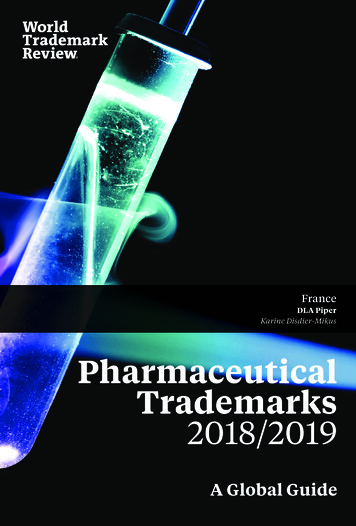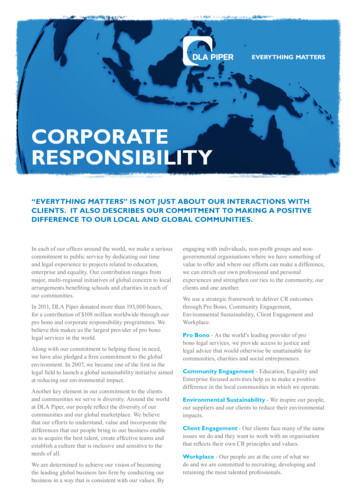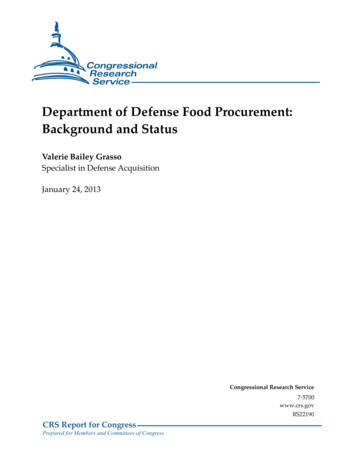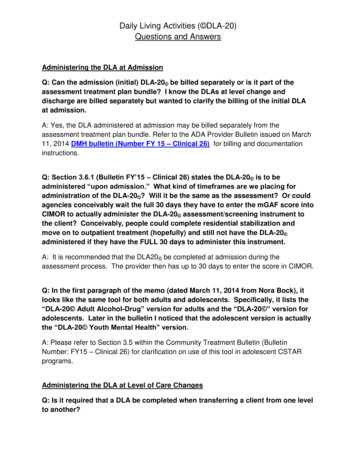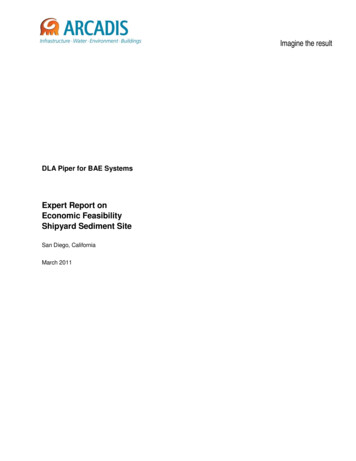
Transcription
Imagine the resultDLA Piper for BAE SystemsExpert Report onEconomic FeasibilityShipyard Sediment SiteSan Diego, CaliforniaMarch 2011
Expert Report onEconomic FeasibilityShipyard Sediment SitePhilip A. SpadaroPrincipal ScientistSan Diego, CaliforniaPoh Boon UngPrincipal EconomistPrepared for:DLA Piper for BAE SystemsMatthew ButcherPrincipal ScientistPaul DoodyTechnical ExpertPrepared by:ARCADIS U.S., Inc.2300 Eastlake Avenue EastSuite 200SeattleWashington 98102Tel 206.325.5254Fax 206.325.8218Our Ref.:B0080242.0000Derek EdgeTechnical ExpertDate:March 2011This document is intended only for theuse of the individual or entity for which itwas prepared and may containinformation that is privileged, confidentialand exempt from disclosure underapplicable law. Any dissemination,distribution or copying of this document isstrictly prohibited.
Table of ContentsSummary of Opinions11. Introduction21.1Background21.2Remedial Options31.3Economic Feasibility Analysis31.4Outline of the Report52. Remedial Options2.15Description of the Options52.1.1DTR-Recommended Option62.1.2Background Remedial Option82.1.3Alternative Remedial Option102.1.3.1Triad Results112.1.3.2Implications of Uncertainties for Protectiveness of Beneficial Uses172.1.3.3Summary of Alternative Remedial Option182.1.3.4Compliance with California State Water Board Resolution No. 92-49193. Costs of Remedial Options203.1Overview of Cost Assessment203.2Discussion of Costs by Option213.2.1DTR-Recommended Option223.2.2Background Remedial Option223.2.3Alternative Remedial Option223.3Present Value Analysis of Costs233.4Discussion of Other Social Costs233.4.1Community Impacts243.4.2Habitat Impacts263.4.3Business Impacts27Shipyard Sediment Site Economic Feasibility Evaluation.docxi
Table of Contents4. Effectiveness Metric4.14.228Data and Methods284.1.1Post-Remediation SWAC Calculation Method – DTR284.1.2Alternative Post-Remediation SWAC Calculation Method29Results and Comparisons of Alternative Remedial Footprints305. Cost-Effectiveness Analysis Results326. References33TablesTable 1Summary of DTR-Recommended OptionTable 2Summary of Remedial ComponentsTable 3Cost Estimate for Remedial Footprint – DTR-Recommended OptionTable 4Summary of Background Remedial OptionTable 5Background Remedial Option Cost EstimateTable 6Summary Results by Station for Alternative Remedial OptionTable 7Summary of Alternative Remedial OptionTable 8Alternative Remedial Option Cost EstimateTable 9Cash Flow AnalysisTable 10Present Value Cost of OptionsTable 11Transportation of Sediment OffsiteTable 12Potential Risks of Transportation of Sediment OffsiteTable 13SWACs for Primary COCs under Alternative ScenariosTable 14SWAC Reduction as a Function of BackgroundTable 15Exposure Reduction by Options (Percent)Shipyard Sediment Site Economic Feasibility Evaluation.docxii
Table of ContentsFiguresFigure 1Site MapFigure 2DTR-Recommended Remedial OptionFigure 3Background Remedial OptionFigure 4Alternative Remedial OptionFigure 5Incremental Cost-Effectiveness Results: 3 Percent Discount RateFigure 6Incremental Cost-Effectiveness Results: 7 Percent Discount RateAppendicesAResumes of ExpertsBRates Used for this WorkCBivalve Normality Results (Exponent 2003)Shipyard Sediment Site Economic Feasibility Evaluation.docxiii
Table of ContentsAcronyms and AbbreviationsAnchorQEAAnchorQEA, L.L.P.BAEDLA Piper for BAE SystemsBRIbenthic response indexCEAcost-effectiveness approachCOCscontaminants of concernCOPCschemicals of potential concerncycubic yardscy/daycubic yards per day Cdegrees CentigradeDTRDraft Technical Report for Tentative Cleanup and Abatement for the ShipyardSediment Site in San Diego BayHPAHstotal high molecular weight polycyclic aromatic hydrocarbonsLAETsLowest Apparent Effects ThresholdsLPLlower predictive limitmg/Lmilligrams per literMMmillionNASSCONational Steel and Shipbuilding Company (General Dynamics subsidiary)OMBOffice of Management and BudgetPCBstotal polychlorinated biphenylspptparts per trillionSDRWQCBSan Diego Regional Water Quality Control BoardSMUssediment management unitssq-ftsquare feetSS-MEQsite-specific mean effects quotientSWACsurface area-weighted average concentrationTBTtributyl tinTMDLTotal Maximum Daily LoadShipyard Sediment Site Economic Feasibility Evaluation.docxiv
Table of ContentsTOCtotal organic carbonTriadcombination of sediment chemistry, sediment toxicity, and benthic community dataUPLupper prediction limitUSACEU.S. Army Corps of EngineersUSEPAU.S. Environmental Protection AgencyWOEweight-of-evidence303(d)California Clean Water Act Section 303(d) List of Water Quality Limited SegmentsShipyard Sediment Site Economic Feasibility Evaluation.docxv
Expert Report onEconomic FeasibilityShipyard Sediment SiteSan Diego, CaliforniaSummary of Opinions Opinion 1: Based on the available data, it is possible to identify Triad results and associated polygonareas which could be considered for remedial action to address uncertainty and to thereby create a“margin of safety” associated with protection of beneficial uses. The resulting alternative footprint, whilesmaller than the currently proposed footprint in the Draft Technical Report for Tentative Cleanup andAbatement Order No. R9-2010-0002 (DTR), provides protection of designated uses, and thus equallyaddresses impairments for nearshore sediments driven by sediment toxicity and/or benthic communityimpacts (i.e., California Clean Water Act Section 303(d) List of Water Quality Limited Segments). Opinion 2: Resultant surface-weighted average concentrations (SWACs) for COCs, based on twoproposed remedial footprints, were compared to current and background SWACs. The results of thatcomparison indicate that increasing the number of locations of remediation from 12 (AlternativeRemedial Option) to 23 (DTR-Recommended Option) and the area of remediation from approximately7.5 to 17.4 acres does not result in a commensurately proportional decrease in SWACs for the COCs atthe Shipyard Sediment Site. Opinion 3: Remediation costs of approximately 29,700,000 for the Alternative Remedial Option havebeen estimated using the cost estimate developed by AnchorQEA, L.L.P. (AnchorQEA) for the DTRRecommended Option. Opinion 4: We anticipate significantly greater social costs including community impacts, habitatimpacts, and business impacts will be incurred with implementation of the Background Remedial Optionthan the other two options. The lowest social costs would be associated with the AlternativeRemedial Option. Opinion 5: We conducted an incremental cost-effectiveness evaluation, which is consistent with theeconomic feasibility assessment as described in California State Water Board Resolution No. 92-49.From a cost-effectiveness evaluation, the Background Remedial Option appears to be substantiallyworse than the other two options. It has greater incremental cost per exposure reduction than the othertwo options. When combined with the other adverse effects including community impacts, businessimpacts, and habitat impacts, social costs that are not quantified, this incremental cost difference will beeven greater. Similar to the conclusions reached in the DTR, the Background Remedial Option is noteconomically feasible; the incremental cost of further reductions outweighs the incremental benefits, andno further reduction in impairment is achieved.Shipyard Sediment Site Economic Feasibility Evaluation.docx1
Expert Report onEconomic FeasibilityShipyard Sediment SiteSan Diego, California1. IntroductionThis report has been prepared by several individuals employed at ARCADIS U.S., Inc. having specificexpertise in the areas of contaminated sediment assessment and management as well as economics.These individuals are listed here along with their areas of expertise and responsibilities for this document: Philip Spadaro, Principal Scientist, responsible for overall report and technical integration Poh Boon Ung, Principal Economist, responsible for economic feasibility analysis Matthew Butcher, Principal Scientist, responsible for statistical analysis of remedial options Paul Doody, Technical Expert, responsible for analysis of remedial option costs Derek Edge, Technical Expert, responsible for development of alternative remedial option.Resumes for these individuals are provided in Appendix A.The scope of this work consisted of reviewing and evaluating available documentation regarding theproposed sediment remediation at the Shipyard Sediment Site, and conducting an economic feasibilityevaluation in accordance with State Water Board Regulation No. 92-49 and other applicable guidance. Theeconomic feasibility evaluation includes evaluation of three remedial options. One of the options consists ofremediation utilizing alternative cleanup levels outlined in Tentative Cleanup and Abatement OrderNo. R9-2010-0002 and the DTR (hereinafter referred to as the “DTR-Recommended Option”). The other twooptions include remediation to background and an option that was developed as part of this work.1.1 BackgroundThe DTR defines the Shipyard Sediment Site as follows:The Shipyard Sediment Site is located on the eastern shore of central San Diego Bay,approximately one half mile south of the Coronado Bridge and half the total distance into theBay. The NASSCO and BAE Systems leaseholds, portions of which lie in the ShipyardSediment Site, are adjacent to each other, have a similar range of water depths, and lie withinthe same hydrologic and biogeographic area. The total combined San Diego Bay water acresincluded in the NASSCO and BAE Systems leaseholds is approximately 56 acres. TheShipyard Sediment Site encompasses the entire 56 water acres of the NASCCO and BAESystems leaseholds. Also included in the Shipyard Sediments Site investigation were areas justShipyard Sediment Site Economic Feasibility Evaluation.docx2
Expert Report onEconomic FeasibilityShipyard Sediment SiteSan Diego, Californiaoutside the northwestern boundary of the BAE Systems leasehold and areas west of theleasehold near the eastern edge of the shipping channel. (SDRWQCB 2010).A map of the Shipyard Sediment Site is provided on Figure 1.Sediment quality at the Site has been studied extensively. The results of such studies are presented innumerous documents including the following: Tentative Cleanup and Abatement Order No. R9-2010-0002 Draft Technical Report for Tentative Cleanup and Abatement Order No. R9-2010-0002 (San DiegoRegional Water Quality Control Board [SDRWQCB] 2010) NASSCO and Southwest Marine Detailed Sediment Investigation (Exponent 2003).These documents and others referenced in this report have been used in forming the opinionsexpressed herein.1.2 Remedial OptionsThis report addresses the following different remedial options: The recommended remedial option presented in the DTR (“DTR-Recommended Option”) A more extensive cleanup option identified in the DTR (“Background Remedial Option”) An alternative remedial area identified here for the purpose of providing another point of comparison forthe cost effectiveness analysis (“Alternative Remedial Option”).These options are described in more detail in Section 2.1.3 Economic Feasibility AnalysisThis report evaluates the economic feasibility of three potential remedial options at the Site. As noted in the1DTR (SDRWQCB 2010), the “San Diego Water Board must apply Resolution No. 92-49 when setting1Policies and Procedures for Investigation and Cleanup and Abatement of Discharges Under Water CodeSection 13304.Shipyard Sediment Site Economic Feasibility Evaluation.docx3
Expert Report onEconomic FeasibilityShipyard Sediment SiteSan Diego, Californiacleanup levels for contaminated sediment if such sediment threatens beneficial uses of the waters of thestate and the contamination or pollution is the result of a discharge of waste. Contaminated sediment mustbe cleaned up to background sediment quality unless it would be technologically or economically infeasibleto do so” (DTR Section 29-2). In particular, State Water Board Resolution No. 92-49 defines the termeconomic feasibility as follows:Economic feasibility is an objective balancing of the incremental benefit of attaining furtherreductions in the concentrations of constituents of concern as compared with the incrementalcost of achieving those reductions. The evaluation of economic feasibility will includeconsideration of current, planned, or future land use, social, and economic impacts to thesurrounding community including property owners other than the discharger. Economicfeasibility, in this Policy, does not refer to the discharger's ability to finance cleanup. Availabilityof financial resources should be considered in the establishment of reasonable complianceschedules. (Cited from 92-49-Section III-H-1-b.)As further discussed in the DTR, economic feasibility involves “estimating the costs to remediateconstituents of concern at a site to background and the costs of implementing other alternative remediallevels. An economically feasible alternative cleanup level is one where the incremental cost of furtherreductions in primary COCs outweighs the incremental benefits” (SDRWQCB [2010], 31-1). Based on theresults of the SDRWQCB’s analysis, cleanup to background sediment quality levels is not economicallyfeasible (SDRWQCB [2010] 31-3, 32-40). The DTR concludes that this alternative remedial footprint(hereafter referred to as the “DTR-Recommended Option”) is protective of beneficial uses.This report includes an independent economic feasibility assessment using a cost-effectiveness approach(CEA). Although Resolution No. 92-49 does not provide specific guidance on how to conduct the economicfeasibility evaluation, the definition provided above is consistent with the use of an incremental CEA. Costeffectiveness analysis is a well-accepted approach, with both the Office of Management and Budget (OMB)and U.S. Environmental Protection Agency (USEPA) providing regulatory guidance for its use. OMB states that CEA should be used for rulemakings for which the primary benefits are improved publichealth and safety. USEPA states that CEA provides useful information to policy makers and conforms to the generalprinciple of minimizing the cost of achieving particular policy goals.Cost-effectiveness analysis is an economic methodology that is widely used to identify and select optionsthat achieve the most effective use of limited resources (see for example OMB 2003, USEPA 2000). Inparticular, the approach measures the added—incremental—costs to society compared to the reductions inconcentration levels for successively more stringent options. By measuring the incremental costs andShipyard Sediment Site Economic Feasibility Evaluation.docx4
Expert Report onEconomic FeasibilityShipyard Sediment SiteSan Diego, Californiaincremental reduction in concentration levels, the approach provides a means for comparing differentoptions and selecting the most cost-effective option.1.4 Outline of the ReportThe remainder of this report is organized as follows. Section 2 describes the three remedial options considered in this analysis. The estimated costs associated with each remedial option are presented in Section 3. Section 4 provides estimates of the changes in average sediment concentrations with differentremediation options. The results of the cost-effectiveness analysis are presented in Section 5. References are included in Section 6. ARCADIS staff resumes are presented in Appendix A. A current rate schedule can be found in Appendix B. Bivalve normality results compiled by Exponent (2003) are presented in Appendix C.2. Remedial OptionsThis section discusses the remedial options considered in this assessment.2.1 Description of the OptionsThe OMB cost-effectiveness guidance recommends evaluating at least three options—the preferredremedial option, a more stringent option, and a less stringent option—while recognizing that looking at acontinuum of options is not feasible. Therefore, the three remedial options listed in Section 1.2 wereevaluated. These three options are discussed in greater detail below.Shipyard Sediment Site Economic Feasibility Evaluation.docx5
Expert Report onEconomic FeasibilityShipyard Sediment SiteSan Diego, California2.1.1 DTR-Recommended OptionThe basis for this option is described in the DTR; however, a description of the DTR-Recommended Optionis provided below to set the stage for discussions about implementation cost estimates and other associatedsocial costs. The following is summarized from the DTR (SDRWQCB 2010).The DTR-Recommended Option footprint is approximately 17.4 acres and was developed for the protectionof aquatic-dependent wildlife and human health. Due to the spatial heterogeneity associated withconcentrations in Shipyard Sediment Site sediment and mobility of aquatic-dependent wildlife and anglertargeted game species, SWACs were utilized to assess potential impacts to human health and aquaticdependent wildlife. The pre-remedy surface sediment concentrations of the primary COCs are provided inTable 1.The DTR-Recommended Option cleanup levels were developed to address human health and wildlifebeneficial use impairments. These cleanup levels (post-remedial SWACs) were developed to mitigateunreasonable health risk to human health or aquatic dependent wildlife, and were the lowest concentrationsthat were technologically and economically feasible to achieve (SDRWQCB 2010). According to the DTR,SWACs were not developed for secondary COCs as they are highly correlated with the primary COCs, andremediation of the primary COCs to post-remedial SWACs will address the secondary COCs. In addition,the remedial footprint will be remediated to background levels to ensure the SWACs are attained on a sitewide basis, and to ensure protection of aquatic life beneficial uses (SDRWQCB 2010).To calculate the SWACs, a geospatial technique (Thiessen polygons) was used to represent the area of theSite represented by each sediment sample. By defining the area most closely associated with eachsampling point, a value for that point (e.g., chemical concentration) can be spatially weighted based on thearea it represents. Sixty-five polygons were delineated based on the 65 sampling station locations at theSite, as shown in Figure 2. The polygons were then ranked based on a number of factors including thecomposite SWAC for the five primary COCs, site-specific mean effects quotient (SS-MEQ), and highestconcentration of individual primary COCs. Additional details on the calculation of SWACs and ranking ofpolygons are provided in the DTR (SDRWQCB 2010). The DTR-Recommended Option remedial footprint isdefined in the DTR as an area including 23 polygons and approximately 17.4 acres, as detailed in Table 2and depicted on Figure 2. The polygon containing station NA22 was excluded from the Site, and is beingevaluated under the Chollas Creek Mouth Total Maximum Daily Load (TMDL). Additional information isprovided in Volume 3 of the DTR (SDRWQCB 2010).The primary components of the DTR-Recommended Option are debris removal and management, dredging,capping, resuspension controls, and monitoring. The remediation approach was described in the DTR and issummarized below for reference.Shipyard Sediment Site Economic Feasibility Evaluation.docx6
Expert Report onEconomic FeasibilityShipyard Sediment SiteSan Diego, California Resuspension controls (silt curtains/oil booms) would be installed to mitigate migration of resuspendedsediment prior to intrusive activities. Debris removal and management would proceed followinginstallation of resuspension controls. Debris quantities were assumed to represent 5% of the totaldredge volume. Dredging would be conducted over approximately 15 acres and target the removal of an estimated143,400 cubic yards (cy) of sediment. Dredging areas have been divided into the northern dredge unit2located adjacent to the BAE Systems Site, which consists of 18 polygons , and the southern dredge unitlocated adjacent to the National Steel and Shipbuilding Company (NASSCO) site, which consists of fivepolygons (Figure 2). Table 1 shows the estimated dredge volume targeted for removal, dredge depth,and area for each polygon. Dredging production was estimated at 1,000 cubic yards per day (cy/day) for approximately 6 monthsper year (September 15 through March 31). This limited dredging “window” was established to protectthe endangered California Least Tern (SDRWQCB 2010; Templeton and Whelan 2010 Pers. Comm.). Dredging would be performed via mechanical techniques from the shoreline or barge, depending on thelocation and depth of material scheduled for removal. Due to shipyard logistics and the presence ofmarine structures, both unconstrained open-water dredging and constrained dredging from the innershipyard will be required. The total removal volume (143,400 cy) has been divided between the twocategories on a percentage basis: 12.5% for unconstrained and 87.5% for constrained dredging (seeTable 3 for removal quantities associated with each dredging type). The percentages were calculatedbased on the dredge footprint located inside and outside the leasehold boundary (Templeton andWhelan 2010 Pers. Comm.) as depicted on Figure 2. Following dredging, confirmation samples would be collected to verify that cleanup levels have beenachieved. If necessary, contingency measures such as second pass dredging and/or residual cappingwould be implemented.2–Second pass dredging has been assumed over half of the remedial area to a depth of 2 feet, resulting in anadditional removal volume of 28,100 cy.–Capping would consist of 3 feet of clean sand assumed over half of the dredge footprint.–Under pier capping would consist of a 3-foot thick layer of clean sand over the existing sediment (SDRWQCB2010) in areas which are inaccessible to dredge equipment (under and adjacent to piers, wharves, andbulkheads). The under pier capping footprint encompasses approximately 2.5 acres (see Table 2 andFigure 2).The term “polygons” is used throughout the text to denote the Thiessen polygons used in the characterization ofthe Site.Shipyard Sediment Site Economic Feasibility Evaluation.docx7
Expert Report onEconomic FeasibilityShipyard Sediment SiteSan Diego, California Eel grass habitat may be disturbed or destroyed by dredging and capping activities. Eel grass habitatmitigation construction and maintenance was assumed at 5% of the total remedial acreage (0.87 acres). Dredged sediment would be offloaded, dewatered, and characterized prior to off-site transportation anddisposal.–Processing is assumed to include transport of removed material to a staging area in the immediate area of theshipyard operations for stockpiling and addition of lime or cement admixture (as necessary) to facilitatedewatering.–Processed sediment would be loaded into 20-ton dump trucks and transported to an off-site disposal facility.An alternative to landfill disposal may be confined aquatic disposal or a near-shore confined disposal facility(SDRWQCB 2010). The estimated schedule for implementation of the DTR-Recommended Option is three constructionseasons to account for the annual California Least Tern restriction window. The construction durationwas provided in the DTR and estimated by AnchorQEA assuming a specific number of disposal trips perday and the quantity of sediment scheduled for removal and disposal (Table 2). Water quality monitoring, sediment monitoring (confirmation sampling), and disposal monitoring wouldbe performed during remediation activities. Water quality monitoring (turbidity and dissolved oxygen)would be conducted at a compliance point outside the construction area during active remediation todemonstrate that implementation of the remedy does not result in violations of water quality standards. Post-remediation monitoring would be initiated 2 years following the completion of the dredging andcapping and continue for a period of up to 10 years (4 events per year).–For human health and aquatic-dependent wildlife beneficial uses, post-remediation monitoring would includesediment chemistry (including a subset of samples to be subjected to bioaccumulation testing using the 28-daymacoma test).–For aquatic wildlife beneficial uses, post-remediation monitoring would include sediment chemistry, toxicity,and benthic community condition assessments (Table 3).2.1.2 Background Remedial OptionSection 17 of the DTR discusses how the background reference pool was selected (SDRWQCB 2010). Insummary, the SDRWQCB selected a group of background stations from three independent sediment qualityinvestigations to compare environmental conditions at the Shipyard Sediment Site with conditions found inother, relatively cleaner areas of San Diego Bay. The criteria for selecting acceptable background stationsincluded: 1) low levels of anthropogenic contaminant concentrations; 2) locations remote fromcontamination sources; 3) similar biological habitat to the Shipyard Sediment Site; 4) sediment total organiccarbon (TOC) and grain size profiles similar to the Shipyard Sediment Site; and 5) adequate sample size forShipyard Sediment Site Economic Feasibility Evaluation.docx8
Expert Report onEconomic FeasibilityShipyard Sediment SiteSan Diego, Californiastatistical analysis and sediment quality data comparability. The 18 locations selected to representbackground conditions were evaluated for sediment chemistry, amphipod survival, and benthic responseindex (BRI) scores in table 17-2 of the DTR.Section 29 of the DTR describes the process used to establish background sediment concentrations for theShipyard Sediment Site (table 29-1) using the 18 selected reference locations (SDRWQCB 2010).Considering the background concentration estimates listed in table 29-1 of the DTR and existing data in alldefined polygons within the Site boundary, all polygons would need to be addressed to achieve the objectiveof reducing concentrations of all COCs to background concentrations within the Site boundary. Theestimated extent of remediation under the Background Remedial Option is shown on Figure 3.The remedial approach for the Background Remedial Option is similar to the approach described above forthe DTR-Recommended Option except for the increased remedial footprint. The expanded footprint includes366 polygons (including NA22) for remediation, as compared to the 23 polygons identified for remediationunder the DTR-Recommended Option. The increase in the number of polygons directly impacts severalparameters which affect the remedial approach, construction schedule, and cost estimates (furtherdiscussed below). These parameters, as detailed in Table 2, include, among other things: approximate totalremedial area (150 acres), approximate remedial area targeted for dredging (142 acres), approximatedredge volume (1,150,000 cy), and under pier area targeted for capping (7.2 acres).Resuspension control installation and debris removal would be conducted prior to dredging activities.Consistent with the DTR-Recommended Option, debris quantities have been estimated at 5% of the totaldredge volume. The northern and southern dredge units located within the remedial footprint consist of35 and 31 polygons, respectively. The estimated extent of dredging is shown on Figure 3. Dredgeproduction and the construction window have been assumed to be the same as the DTR-RecommendedOption. The specific dredge volume targeted for removal, dredge depth, and area for each polygon areprovided in Table 4. Unconstrained dredging would be conducted at about 60% of the dredge area, whereasconstrained dredging would be conducted over about 40% of the area. The results of confirmation samplingconducted following dredging will determine contingency measures, if necessary. Second pass dredging isassumed at the same percentage as the DTR-Recommended Option, resulting in an estimated removal of240,000 cy, while residual capping assumes 360,000 cy of sand placement.The under pier capping component of the remedy would be conducted in areas which are inaccessible todredge equipment, and include areas under and adjacent to piers, wharves, and bulkheads. The under pier3The Background Remedial Option includes polygon NA22, making the total number of polygons 66. NA22 wasexcluded from the DTR-Recommended Option as described in SDRWQCB (2010) because a TMDL is beingdeveloped for the mouth of Chollas Creek, which encompasses NA22. This TMDL will reportedly apply to sediments inthe mouth of Chollas Creek.Shipyard Sediment Site Economic Feasibility Evaluation.docx9
Expert Report onEconomic FeasibilityShipyard Sediment SiteSan Diego, Californiacapping footprint encompasses approximately 7.2 acres, as detailed in Table 2 and depicted on Figure 3.The under pier capping component of the remedy would consist of the placement of a 3-foot thick cleansand layer. Eel grass habitat mitigation has been estimated at 5% of the remedial acreage.Sediment processing and management would be conducted similar to that of the DTR-RecommendedOption. Processed sediment would be transported offsite and disposed at a landfill regulated to accept suchwaste (SDRWQCB 2010). Implementation of the Background Remedial Option has been estimated at 14construction seasons, which accounts for the annual California Least Tern restriction window (SDRWQCB2010; Templeton and Whelan 2010 Pers. Comm.).Monitoring activities for the Background Remedial Option are the same as those specified for theDTR-Recommended Option (see Section 2.1.1) and include water quality monitoring, sediment monitoring(confirmation sampling), and disposal monitoring. The variation between options is the duration and numberof samples/locations which have increased due the size of the remedial footprint. See Tables 3 and 5 foradditional details.2.1.3 Alternative Remedial OptionThe DTR assessed potential risks to aquatic life associated with exposure to site sediments (SDRWQCB2010). Recogni
Table 6 Summary Results by Station for Alternative Remedial Option Table 7 Summary of Alternative Remedial Option Table 8 Alternative Remedial Option Cost Estimate . Table 9 Cash Flow Analysis . Table 10 Present Value Cost of Options . Table 11 Transportation of Sediment Offsite . Table 12 Potential Risks of Transportation of Sediment Offsite
